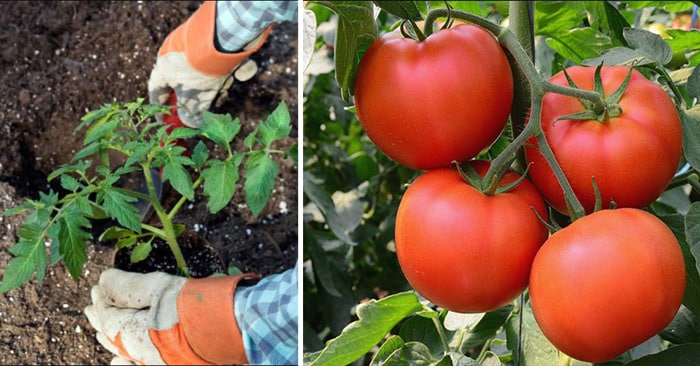
Tomatoes are among the most popular crops for home gardeners, and for good reason. Their juicy, flavorful fruits are versatile in the kitchen and packed with nutrients.
But achieving the perfect tomatoes requires more than just planting seeds or seedlings. What you put in the planting hole can make all the difference.
By enriching the soil with specific nutrients and organic materials, you can ensure your tomato plants grow strong and produce an abundant harvest.
Here are eight things you should add to your tomato planting hole for the best tomatoes ever.
1. Compost
Compost is the foundation of healthy soil. It’s rich in organic matter and nutrients that feed tomato plants throughout the growing season.
- Why It Works: Compost improves soil structure, enhances moisture retention, and provides essential nutrients like nitrogen, phosphorus, and potassium.
- How to Use It: Add 1-2 handfuls of well-rotted compost to the planting hole before placing the tomato plant. Mix it lightly with the surrounding soil.
2. Bone Meal
Bone meal is an excellent source of phosphorus, which is crucial for root development and flower production.
- Why It Works: Phosphorus promotes strong roots, helping tomato plants establish quickly and produce more fruits.
- How to Use It: Sprinkle 1-2 tablespoons of bone meal into the planting hole and mix it with the soil. Avoid overapplication, as too much phosphorus can inhibit other nutrient uptake.
3. Eggshells
Eggshells are a fantastic natural source of calcium, a nutrient essential for preventing blossom-end rot in tomatoes.
- Why It Works: Calcium strengthens cell walls, leading to healthier fruits and plants.
- How to Use It: Crush 3-4 eggshells into small pieces and place them at the bottom of the planting hole. They decompose slowly, releasing calcium over time.
4. Epsom Salt
Epsom salt is a great way to supply magnesium, another key nutrient for tomatoes.
- Why It Works: Magnesium aids in chlorophyll production and helps plants absorb phosphorus and nitrogen more effectively.
- How to Use It: Add 1 tablespoon of Epsom salt to the planting hole and mix it with the soil. You can also dissolve it in water and use it as a foliar spray during the growing season.
5. Coffee Grounds
Used coffee grounds are an excellent source of nitrogen, a nutrient vital for lush foliage and vigorous growth.
- Why It Works: Coffee grounds improve soil texture and provide a slow-release form of nitrogen.
- How to Use It: Sprinkle a small handful of used coffee grounds in the planting hole and mix it with the soil. Avoid using fresh coffee grounds, as they can be too acidic.
6. Banana Peels
Banana peels are a natural source of potassium, which is critical for fruit development and disease resistance.
- Why It Works: Potassium enhances water movement, enzyme activation, and overall plant resilience.
- How to Use It: Cut a banana peel into small pieces and bury it in the planting hole. The peel will decompose, releasing potassium and other trace nutrients over time.
7. Fish Meal
Fish meal is a nutrient-rich organic fertilizer that provides a balanced supply of nitrogen, phosphorus, and potassium.
- Why It Works: It promotes strong root systems, vigorous growth, and higher fruit yields.
- How to Use It: Add 1-2 tablespoons of fish meal to the planting hole and mix it thoroughly with the soil. Its slow-release formula ensures long-term nutrient availability.
8. Mycorrhizal Fungi
Mycorrhizal fungi are beneficial microorganisms that form symbiotic relationships with plant roots.
- Why It Works: These fungi improve nutrient and water uptake, enhance root growth, and increase the plant’s resistance to stress and disease.
- How to Use It: Sprinkle mycorrhizal inoculant powder directly onto the roots or into the planting hole before setting the tomato plant.
How to Prepare the Perfect Tomato Planting Hole
Follow these steps to create an ideal environment for your tomato plants:
- Dig a Deep Hole: Tomato plants thrive when their roots are buried deep. Dig a hole that’s at least twice as deep as the root ball of the seedling.
- Remove Lower Leaves: Pinch off the lower leaves of the tomato plant to prevent them from rotting when buried.
- Add the Amendments: Place the recommended amounts of compost, bone meal, eggshells, Epsom salt, coffee grounds, banana peels, fish meal, and mycorrhizal fungi into the hole.
- Mix with Soil: Blend the amendments with the surrounding soil to ensure even distribution of nutrients.
- Plant Deeply: Place the tomato plant in the hole, burying it up to the first set of leaves. This encourages the development of additional roots along the buried stem.
- Water Thoroughly: After planting, water the tomato deeply to help the soil settle and provide immediate hydration to the plant.
Additional Tips for Growing the Best Tomatoes
- Choose the Right Variety: Select tomato varieties suited to your climate and gardening goals, whether you prefer heirloom, cherry, or beefsteak tomatoes.
- Mulch the Soil: Apply a layer of organic mulch around the base of the plants to retain moisture, regulate soil temperature, and suppress weeds.
- Provide Support: Use stakes, cages, or trellises to keep tomato plants upright and prevent fruit from touching the ground.
- Water Consistently: Water deeply and consistently, especially during dry spells, to prevent stress and blossom-end rot.
- Prune Regularly: Remove suckers (small shoots growing between the main stem and branches) to direct energy toward fruit production.
- Fertilize Wisely: Use a balanced fertilizer during the growing season, but avoid over-fertilizing with nitrogen, which can lead to excessive foliage growth at the expense of fruit.
Why This Method Works
Adding these eight items to your tomato planting hole creates a nutrient-rich environment that supports every stage of tomato growth.
From promoting root development and enhancing foliage to boosting fruit production and disease resistance, these natural amendments provide everything your plants need to thrive.
By taking the time to prepare your soil and use these tried-and-true techniques, you’ll enjoy healthier plants and tastier tomatoes all season long.
Growing the best tomatoes doesn’t have to be complicated. By incorporating compost, bone meal, eggshells, Epsom salt, coffee grounds, banana peels, fish meal, and mycorrhizal fungi into your planting hole, you’ll create an optimal environment for your plants to flourish.
This method is simple, cost-effective, and eco-friendly, making it a win for both your garden and the planet.
Start implementing these tips in your garden today and get ready to enjoy an abundant harvest of delicious, homegrown tomatoes!


